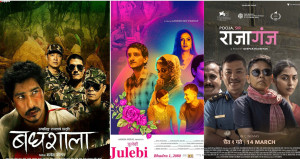Movies
Intriguing yet imperfect: Looking back at ‘Seto Bagh’
The 2015 film boasts of remarkable visual aesthetics, but struggles to strike a balance between historical accuracy and engaging storytelling.
Anish Ghimire
Directed by Nir Shah, ‘Seto Bagh’ endeavours to bring the historical era of Nepal’s Rana regime to life, but it lands somewhere in the middle, neither impressing nor entirely disappointing. The film boasts remarkable visual aesthetics and good performances, but it struggles to strike a perfect balance between historical accuracy and engaging storytelling. Based on the renowned novel of the same name written by Diamond Shumsher Rana, the movie takes us back to the turbulent times of the Rana regime in Nepal during the 19th century.
The movie’s central plot describes the clash between the sons and brothers of Nepal’s first Rana prime minister Jung Bahadur Rana (played by late BS Rana). After his death, Jung Bahadur declared that his brothers would continue to serve as prime ministers. This trend set by his father didn’t sit right with the eldest son, Jagat Jung (played by Manish Bhandari). After his father’s passing, he publicly opposes this choice and demands that he—not his uncle Ranodip Singh—become prime minister.
Jung Bahadur’s brothers Ranodip Singh and Dhir Shumsher (played by Rabi Giri) are obviously not happy and plot to confine Jagat at a jail in India. But when Ranodip Singh changes his mind overnight and calls Jagat Jung back to the valley to crown him the title of Shree Tin (a title given to the Prime Minister), his adversaries plot a bloodbath where Ranodip Singh, Jagat Jung, Juddha Pratap aka Nati Jarnel (Son of Jagat Jung), and other close members are murdered mercilessly. Immediately after, we see the rise of Bir Shumsher (played by Sunil Jung Rayamajhi), the eldest son of Dhir Shumsher, as he becomes the third Rana Prime Minister. From here till the fall of the Rana Regime in 1951 AD, the six (out of 17) sons of Dhir Shumsher took the throne of Prime Minster.
My immediate concern when deciding to watch the movie was, is there any way such a long and profound history finds the space it deserves in a two-hour movie? As the movie progressed, I was right. The story seems a bit rushed at times, whereas some scenes seem redundant. For example, there is no buildup or aftermath shown when Dhir Shumsher chokes on a fish’s bone and dies. His death was a page-turner in the history of the Rana regime, but the movie fails to pick up on that.
The film’s strongest aspect, I think, lies in its attention to detail and production design. ‘Seto Bagh’ successfully transports the audience back to 19th-century Nepal, recreating the grandeur of the Rana palaces and the scenic landscapes. The costumes and set pieces add authenticity to the historical setting, providing a visually appealing experience. The characters, too, seem to fit the historical role they have been assigned.
However, BS Rana’s portrayal of Jung Bahadur Rana could have been given more priority. For such a highly anticipated character, there are only glimpses of his brilliance. Although we can see the ruler’s commanding presence, it still feels like the filmmakers have missed out on so much more. The character development is lacking, and the screenplay fails to explore his motivations deeply enough, leaving the audience craving a more intimate understanding of this historical figure.
While the film’s deliberate pacing may not be for everyone, it allows for a deeper understanding of the characters’ motivations. ‘Seto Bagh’ is not just about the events of the Rana regime; it delves into the human psyche, exploring the cost of ambition and the price of wielding power. The screenplay also navigates through crucial aspects of the Rana regime, such as political conspiracies, strategic alliances, and confrontations. A character named Bhola (played by Rajaram Poudyal) depicts every other narcissist who believes in ‘jasko shakti usko bhakti’ (worship those in power) and changes sides when favourable. Such characters play a huge role in the falling or rising of certain regimes. Bhola takes the side of Jagat Jung in the beginning but later turns his back and assists the sons of Dhir Shumsher in his assassination. In the end, Nir Shah narrates, ‘In Nepal, many things have changed but Bhola tantra (tendency) is still there.’
Even with such a relevant message, the movie seems to rely heavily on the assumption that the audience has prior knowledge of Nepali history and the Rana regime. As a result, many viewers may find it challenging to fully grasp the historical nuances and cultural references, leaving them feeling alienated from the film. The central plot of the movie is intense and requires a deep understanding of Rana history. Without such understanding, the movie becomes frustratingly confusing. This is why the film’s appeal may be limited primarily to history enthusiasts or those familiar with Nepal’s cultural and its historical past.
‘Seto Bagh’ is a respectable attempt at presenting a crucial period in Nepal’s history. While it does well in its attention to detail, good performances, and captivating visuals, the film struggles to find a cohesive balance between historical accuracy and compelling storytelling. It’s a decent historical drama that may appeal more to a niche audience rather than offering universal appeal. Nevertheless, it remains a valiant effort in portraying Nepal’s rich heritage on the silver screen.
Seto Bagh

Director: Nir Shah
Language: Nepali
Subtitles: Not available
Cast: BS Rana, Shyam Rai, Anjana Kattel, Anita Dangal, Rita Kattel
Year: 2015
Available on: YouTube




 16.12°C Kathmandu
16.12°C Kathmandu











%20(1).jpg&w=300&height=200)

